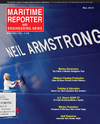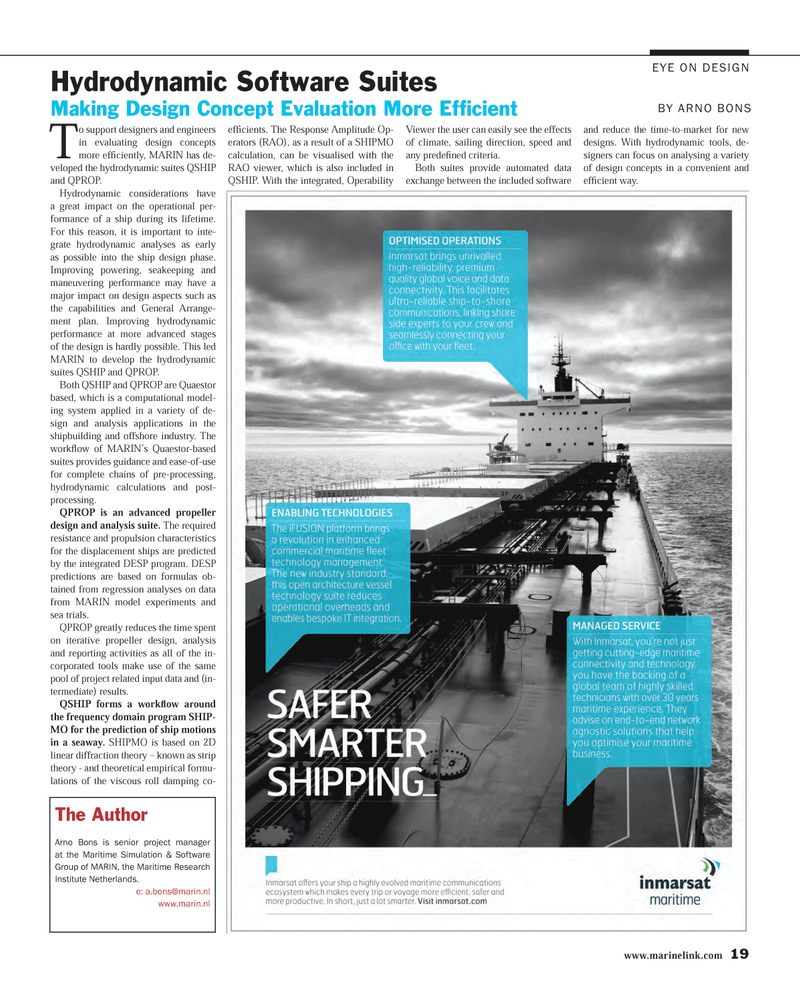
Page 19: of Maritime Reporter Magazine (May 2014)
Marine Electronics Edition
Read this page in Pdf, Flash or Html5 edition of May 2014 Maritime Reporter Magazine
www.marinelink.com 19
T o support designers and engineers in evaluating design concepts more effi ciently, MARIN has de- veloped the hydrodynamic suites QSHIP and QPROP.
Hydrodynamic considerations have a great impact on the operational per- formance of a ship during its lifetime.
For this reason, it is important to inte- grate hydrodynamic analyses as early as possible into the ship design phase.
Improving powering, seakeeping and maneuvering performance may have a major impact on design aspects such as the capabilities and General Arrange- ment plan. Improving hydrodynamic performance at more advanced stages of the design is hardly possible. This led
MARIN to develop the hydrodynamic suites QSHIP and QPROP.
Both QSHIP and QPROP are Quaestor based, which is a computational model- ing system applied in a variety of de- sign and analysis applications in the shipbuilding and offshore industry. The workfl ow of MARIN’s Quaestor-based suites provides guidance and ease-of-use for complete chains of pre-processing, hydrodynamic calculations and post- processing.
QPROP is an advanced propeller design and analysis suite. The required resistance and propulsion characteristics for the displacement ships are predicted by the integrated DESP program. DESP predictions are based on formulas ob- tained from regression analyses on data from MARIN model experiments and sea trials.
QPROP greatly reduces the time spent on iterative propeller design, analysis and reporting activities as all of the in- corporated tools make use of the same pool of project related input data and (in- termediate) results.
QSHIP forms a workfl ow around the frequency domain program SHIP-
MO for the prediction of ship motions in a seaway. SHIPMO is based on 2D linear diffraction theory – known as strip theory - and theoretical empirical formu- lations of the viscous roll damping co- effi cients. The Response Amplitude Op- erators (RAO), as a result of a SHIPMO calculation, can be visualised with the
RAO viewer, which is also included in
QSHIP. With the integrated, Operability
Viewer the user can easily see the effects of climate, sailing direction, speed and any predefi ned criteria.
Both suites provide automated data exchange between the included software and reduce the time-to-market for new designs. With hydrodynamic tools, de- signers can focus on analysing a variety of design concepts in a convenient and effi cient way.
EYE ON DESIGN
The Author
Arno Bons is senior project manager at the Maritime Simulation & Software
Group of MARIN, the Maritime Research
Institute Netherlands. e: [email protected] www.marin.nl
Hydrodynamic Software Suites
Making Design Concept Evaluation More Effi cient
BY ARNO BONS
MR #5 (18-25).indd 19 5/1/2014 10:11:55 AM

 18
18

 20
20
